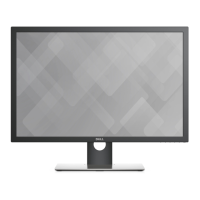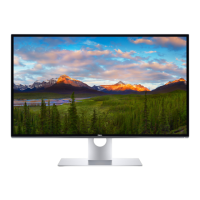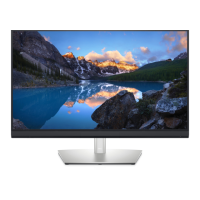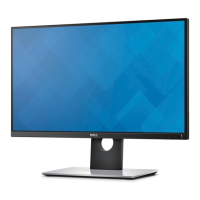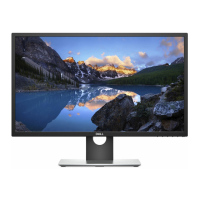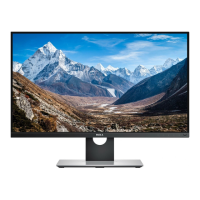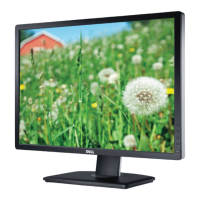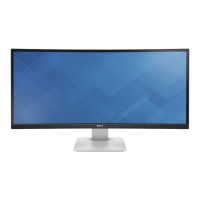Do you have a question about the Dell UltraSharp UP3017 and is the answer not in the manual?
Lists components shipped with the monitor, including monitor, stand riser, stand base, and cables.
Details the monitor's active matrix, TFT, LCD, LED backlight, resolution, connectivity, and color standards.
Identifies front panel buttons and their functions for monitor operation.
Identifies VESA mounting holes, stand release, security lock, and other back panel ports.
Illustrates USB downstream ports and various input/output connectors on the monitor.
Details screen type, dimensions, pixel pitch, viewing angle, brightness, and contrast ratio.
Provides details on video input signals, input voltage, frequency, current, and inrush current.
Lists connector types, signal cable types, dimensions, and weights of the monitor.
Covers compliant standards, operating conditions, and power management modes.
Explains warning messages displayed in active-off mode or when Dynamic Contrast is active.
Provides step-by-step instructions for attaching the monitor stand to the base.
Guides on adjusting tilt, swivel, vertical extension, and rotating the monitor.
Illustrates connecting DP, mDP, HDMI, and USB cables for setup.
Instructions for organizing cables and safely removing the monitor stand.
Provides instructions for mounting the monitor on a wall using a VESA-compatible kit.
Instructions for turning on the monitor and using front panel buttons.
Details the function of each front-panel button for preset modes, input, and OSD access.
Guides on accessing and navigating the On-Screen Display (OSD) menu system.
Explains how to adjust brightness, contrast, and select video input sources via OSD.
Details how to adjust color settings, including input format and reset options.
Describes various preset modes like Standard, ComfortView, Multimedia, and Game.
Covers adjustments for aspect ratio, sharpness, response time, and other display parameters.
Explains the Picture-in-Picture/Picture-by-Picture function for multi-input display.
Details settings for power button LED, USB standby mode, and energy reset.
Covers OSD settings like language, transparency, timer, lock, and menu reset.
Explains DDC/CI, LCD conditioning, and factory reset options for OSD.
Explains various OSD warning messages and power save mode notifications.
Guides on how to run the monitor self-test to check for functionality issues.
Explains how to run built-in diagnostics to determine screen abnormality sources.
Lists common symptoms like no picture, missing pixels, and their possible solutions.
Addresses specific issues like USB problems, DP connection errors, and image display.
Provides safety warnings and directs users to regulatory compliance websites.
Offers guidance on obtaining online support and contacting Dell for assistance.
Step-by-step guide for setting the display resolution to 2560 x 1600 in Windows.
Provides instructions for cleaning and maintaining the monitor for optimal performance.
Lists components shipped with the monitor, including monitor, stand riser, stand base, and cables.
Details the monitor's active matrix, TFT, LCD, LED backlight, resolution, connectivity, and color standards.
Identifies front panel buttons and their functions for monitor operation.
Identifies VESA mounting holes, stand release, security lock, and other back panel ports.
Illustrates USB downstream ports and various input/output connectors on the monitor.
Details screen type, dimensions, pixel pitch, viewing angle, brightness, and contrast ratio.
Provides details on video input signals, input voltage, frequency, current, and inrush current.
Lists connector types, signal cable types, dimensions, and weights of the monitor.
Covers compliant standards, operating conditions, and power management modes.
Explains warning messages displayed in active-off mode or when Dynamic Contrast is active.
Provides step-by-step instructions for attaching the monitor stand to the base.
Guides on adjusting tilt, swivel, vertical extension, and rotating the monitor.
Illustrates connecting DP, mDP, HDMI, and USB cables for setup.
Instructions for organizing cables and safely removing the monitor stand.
Provides instructions for mounting the monitor on a wall using a VESA-compatible kit.
Instructions for turning on the monitor and using front panel buttons.
Details the function of each front-panel button for preset modes, input, and OSD access.
Guides on accessing and navigating the On-Screen Display (OSD) menu system.
Explains how to adjust brightness, contrast, and select video input sources via OSD.
Details how to adjust color settings, including input format and reset options.
Describes various preset modes like Standard, ComfortView, Multimedia, and Game.
Covers adjustments for aspect ratio, sharpness, response time, and other display parameters.
Explains the Picture-in-Picture/Picture-by-Picture function for multi-input display.
Details settings for power button LED, USB standby mode, and energy reset.
Covers OSD settings like language, transparency, timer, lock, and menu reset.
Explains DDC/CI, LCD conditioning, and factory reset options for OSD.
Explains various OSD warning messages and power save mode notifications.
Guides on how to run the monitor self-test to check for functionality issues.
Explains how to run built-in diagnostics to determine screen abnormality sources.
Lists common symptoms like no picture, missing pixels, and their possible solutions.
Addresses specific issues like USB problems, DP connection errors, and image display.
Provides safety warnings and directs users to regulatory compliance websites.
Offers guidance on obtaining online support and contacting Dell for assistance.
Step-by-step guide for setting the display resolution to 2560 x 1600 in Windows.
Provides instructions for cleaning and maintaining the monitor for optimal performance.
| Color | black, silver, black |
|---|---|
| Screen Type | led |
| Tiltable | yes |
| Touch Screen | no |
| Webcam | no |
| OS Compatibility | not applicable |
| Screen Size | 30 inches |
| Panel Type | ips |
| Aspect Ratio | 16:10 |
| Resolution | 2560 x 1600 |
| Native Resolution | 2560 x 1600 |
| Refresh Rate | 60hz |
| Horizontal Viewing Angle | 178 degrees |
| Vertical Viewing Angle | 178 degrees |
| Response Time | 6 milliseconds |
| Brightness | 350 candela per square meter |
| Contrast Ratio | 1000:1 |
| Synchronization | not applicable |
| Horizontal Scan Rate | 98.71 kilohertz |
| HDR | no |
| Built-In Speakers | no |
| HDMI Ports | 2 |
| Voice Assistant | no |
| Power Saving Mode | 0.3 watts |
| Power Consumption | 108 watts |
| Depth with Stand | 8 27/50 inches |
| Height with Stand | 24 89/100 inches |
| Width with Stand | 27 inches |
| Depth without Stand | 2 3/10 inches |
| Height without Stand | 17 3/5 inches |
| Net Weight without Stand | 14.31 pounds |
